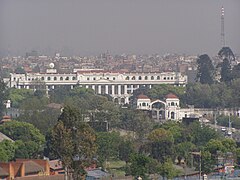Singha Durbar
| Singha Durbar | |
|---|---|
 |
|
| General information | |
| Architectural style | Neoclassical architecture, Palladian architecture, and European styles of architecture |
| Town or city | Kathmandu |
| Country | Nepal |
| Cost | Unknown |
| Client | Chandra Shumsher JBR |
| Technical details | |
| Structural system | Brick and Mortar |
| Design and construction | |
| Architect | Kumar Narsingh Rana, Kishor Narsingh Rana |
Singha Durbar (Nepali: सिंहदरवार; translation: Lion's Palace) is a palace in Kathmandu, the capital of Nepal. The palace complex lies in the centre of Kathmandu, to the north of the Babar Mahal and Thapathali Durbar and east of Bhadrakali. This palace was built by Chandra Shumsher JBR in June 1908.
It was built by Shumsher immediately after accession to the post of Prime Minister. It was initially a small private residence, but grew bigger during the construction. Immediately after construction Shumsher sold this property to the Government of Nepal for 20 million Nepali rupee as the official residence of Prime minister. After his death in 1929, it was used as the official residence of prime ministers of Rana dynasty except Padma Shumsher JBR, who lived in his own Bishalnagar Durbar. The last Rana Prime minister to occupy Singha Durbar was Mohan Shumsher JBR. Even after the fall of Rana Dynasty in 1951, Mohan used this place, but in 1953 he was ordered by His Majesty's Government to leave the palace which became a National Property.
The structure was designed by Kumar Narsingh Rana, Kishor Narsingh Rana. The architecture of the palace is a unique example of merging building traditions, including Palladian, Corinthian, Neoclassical mansions along with Baroque architecture.
Before the fire of 1973, Singha Durbar had 7 courtyards and 1700 rooms with marbled floor, painted ceilings, silver furniture and expanses of crystal lighting.
The State Hall is the largest and the most decorated room in this palace. This hall is adorned with foreign imported art pieces like Murano glass crystal chandeliers, Belgian mirrors along with English stained glass doors and Italian marble floors with floral patterns in walls and ceilings.
...
Wikipedia
